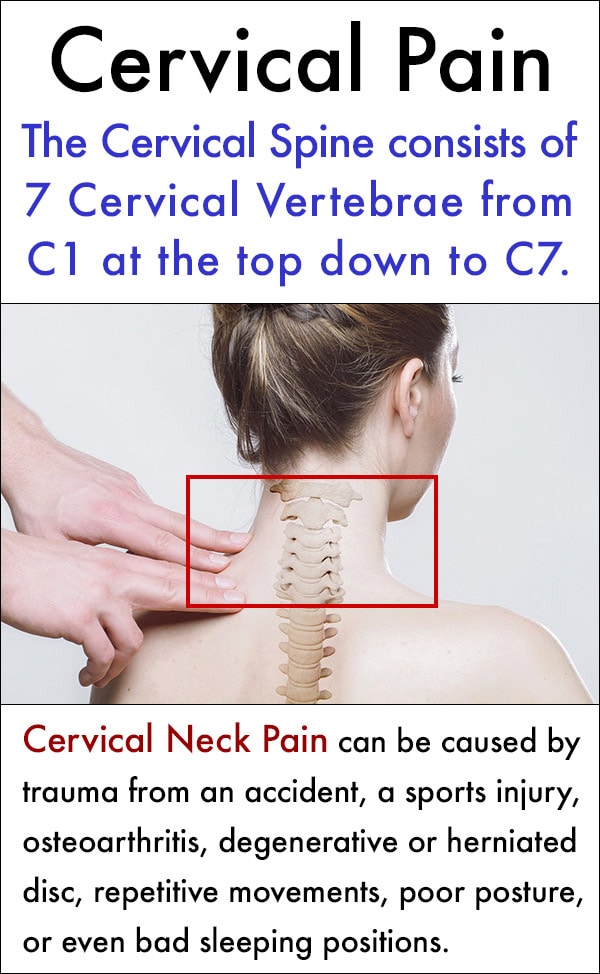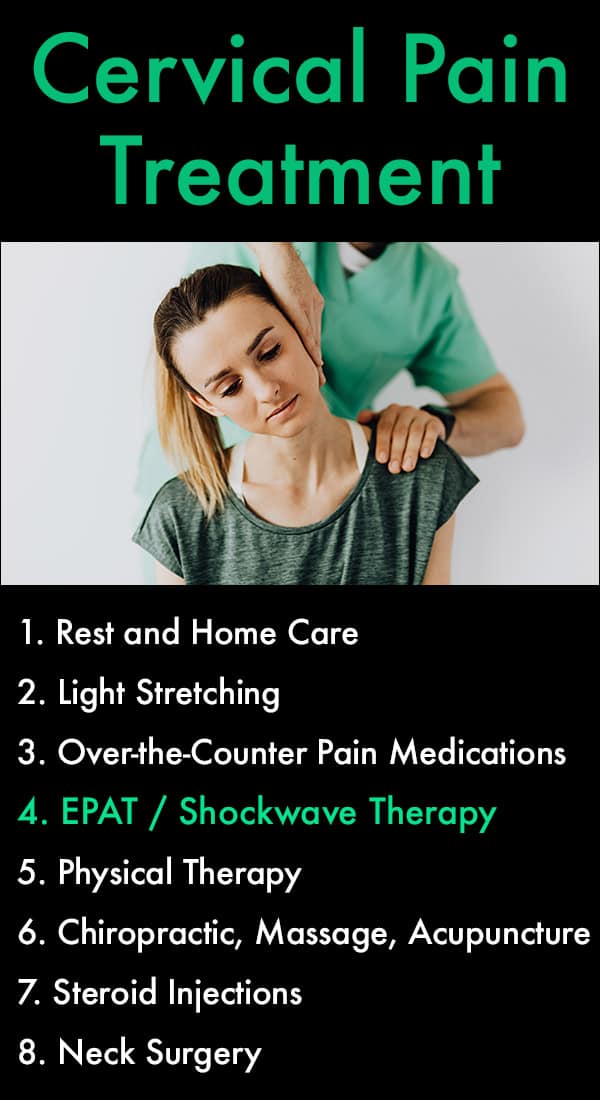Cervical pain is quite literally and figuratively a pain in the neck. Not only does it produce physical pain, but it also makes it difficult to sleep, and challenging to perform normal daily activities.
The complex system of nerves, joints, bones, muscles, and other soft tissue that make up the neck and cervical spine all work together to support the head and provide mobility.
There are a number of reasons why people experience cervical neck pain, but understanding what causes it, recognizing the early symptoms, and treating it appropriately can help reduce the time it takes to heal and recover.
What is Cervical Pain?
Starting at the base of the skull, the cervical spine consists of seven segments of vertebra, referred to as the cervical vertebrae that are numbered C1 (top) through C7 (bottom).
The cervical spine then connects to the thoracic section of the spine below it, which runs through the chest, in segments C7 through T1.
Pain in the C1 through C7 region, which can be caused due to a variety of different factors, from injury to irritation along the nerve pathways, or even underlying illness, is formally known as cervical spine pain.
Most of us simply refer to it as neck pain, or less fondly as a pain in the neck.
The intensity of pain can range from mildly irritating to debilitating discomfort that interferes with a person’s ability to move normally, sleep, or concentrate on necessary tasks.
In some cases, cervical spine pain issues can also cause discomfort in the shoulders, hands, legs, and other areas of the body. Many people mistake it as upper back pain although it is actually higher up in the neck area.
Depending on the particular cause of cervical pain, recovery time with treatment can take a few days to a few weeks. Pain that lasts longer than that is likely signaling a more serious underlying medical condition that must be addressed.
Cervical Pain Symptoms
As with other types of injuries, cervical spine neck pain can be acute, meaning it lasts approximately four weeks or less.
Chronic cervical neck pain, on the other hand, involves discomfort that persists for three months or longer.
Symptoms of cervical spine pain will vary based on each individual’s condition, including the cause and duration of the issue.

Typical cervical spine neck pain can include some of the following:
- Sharp pain in a specific location of the cervical spine
- Dull pain located in a broader area of the neck
- Poor or limited range of motion
- Stiffness in the neck
- Muscle spasms in the neck, upper shoulder, or back
- Pain or tingling that can radiate down from the neck into the shoulders, arms, or hands
- Headaches in the back of the head
Recognizing the early signs of cervical pain is useful in seeking medical intervention and treatment.
It can also help to know what causes this type of neck pain so that specific activities can be avoided or amended to reduce the likelihood of continued issues.
Cervical Pain Causes
Most people will experience neck pain at various points in their life.
One of the most common causes of neck pain occurs when the soft tissue – tendons, ligaments, muscles – that help support the cervical spine are strained or sprained as a result of injury, overtraining syndrome, or overextension.
Other common causes of cervical neck pain can include:
- Incorrect or poor posture for long periods of time that can occur during stretches of work or leisure. For instance, sitting hunched over in front of a computer can lead to neck pain, as well as hours playing videogames on a phone or computer in a bad resting position
- Sleeping in a position that twists or pinches the neck is a common occurrence
- Repetitive movements involving the neck, such as continued turning from side to side or just one side, and constantly looking up or down. These movements can lead to inflammation in the tendons, ligaments, and muscles that cause neck pain
- Trauma from an accident, related to sports, a vehicle crash, or other types of forceful impact to the body and the neck
- Osteoarthritis in the cervical spine is caused when cartilage in the neck wears down over time
- Degenerative cervical disc disease can lead to changes in the spine’s makeup and cause pain
- A herniated cervical disc occurs when the protective outer layer of an intervertebral disc is partially or completely torn
Living with neck and cervical pain can be incredibly difficult, which is why it’s important to seek appropriate treatment as soon as neck pain presents.
Cervical Pain Treatment
Self-care can play a big part in avoiding and treating cervical pain that is not caused by serious injury or underlying medical conditions.
More serious issues will require seeing a physician who will want to discuss recent activity, symptoms, and perform a physical examination.
Imaging of the neck, such as an x-ray or an MRI, will also probably be prescribed so that any structural or soft-tissue issues can be ruled out or identified.
In most cases of neck and cervical pain, treatments will start with conservative approaches and become more involved if the issues are not resolved.

Cervical Pain Treatment Can Include:
1. Rest and Home Care
Rest and Home Care means reducing physical activity levels, specifically any movement that will irritate the neck, combined with ice on the affected area to reduce inflammation.
Applying heat can also help relax bunched-up or stiff muscle fibers causing pain as well. Ice or heat can be applied several times a day, but limit each session to 20 minutes or less.
2. Light Stretching
As the neck heals, light stretching can help alleviate some muscle tightness and improve range of motion, though it’s important to avoid any stretches that increase pain.
3. Over-the-Counter Pain Medications
Non-steroidal anti-inflammatory pain medications, such as ibuprofen (Advil) or naproxen (Aleve) can be used as directed to reduce both pain and inflammation. Anti-inflammatory pain meds should be used in the early stages while resting the neck.
4. EPAT / Shockwave Therapy Treatment
EPAT Therapy is a painless and non-invasive therapeutic approach for treating and healing many types of injuries, including cervical pain.
It is also known as Extracorporeal Shockwave Therapy because it uses pressure waves or “shockwaves” to treat and heal injuries.
A Shockwave Machine delivers high or low-energy pressure waves that are focused directly at the area of the neck experiencing pain caused by damaged or injured soft-tissue.
Shockwave treatment is ideal for reducing inflammation, increasing blood flow, forming new blood vessels, and speeding up the healing and recovery process.
EPAT / Shockwave Therapy can also be administered while a person is in the rest phase of recovery, during physical therapy, or even while a person is trying to maintain peak physical performance.
5. Physical Therapy
Physical Therapy for cervical neck pain can be useful for improving pain and neck stiffness, educating patients about effective stretches or warm-up exercises, and teaching proper posture and other techniques for specific activities.
Physical therapists can also help develop training regimens to strengthen the muscles in the neck and lessen the chances of overtraining and overuse injuries.
6. Chiropractic Care, Massage Therapy, and Acupuncture
Chiropractic care, massage therapy, and acupuncture are three types of treatment methods with the same goal of reducing inflammation, releasing muscle tension in the neck, and providing relief from stiffness and pain.
While these are all different approaches, they can be effective for treating a wide range of injuries including cervical neck pain.
Depending on the cause of the injury, some of these methods may be better suited than others for specific conditions and a doctor or physical therapist might be able to recommend the best one for each person.
7. Steroid Injections
Used in more serious cases, like disc herniation or degeneration, corticosteroid injections in the outer layer of the spinal canal is sometimes used to decrease inflammation.
This is a more invasive treatment option and should be used with some caution as steroids can damage nearby, healthy tissue in certain cases.
8. Neck Surgery
There are several types of neck surgery for people with more serious medical conditions causing cervical pain. Surgery for neck pain is usually only considered after all other treatment methods have been exhausted.
There are, of course, some risks involved when considering surgery, especially around the spine and neck, all of which should be thoroughly discussed with your physician ahead of time.
Everyone will probably experience some form of neck pain in their life, especially as they age, and some if they are very active physically, or work in certain types of occupations.
Because the spinal system is so complex and connects to every part of the body, recognizing any issues and treating them early is crucial to avoid further damage that might require surgery.
If cervical pain appears, see a doctor as soon as possible and hopefully these treatment methods can improve healing and recovery to get back on track more quickly.